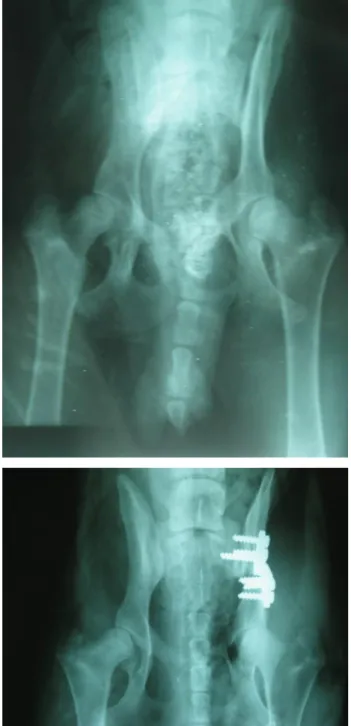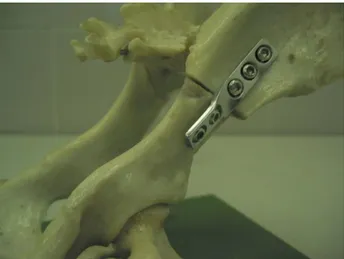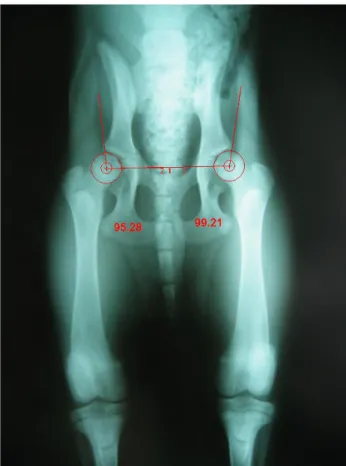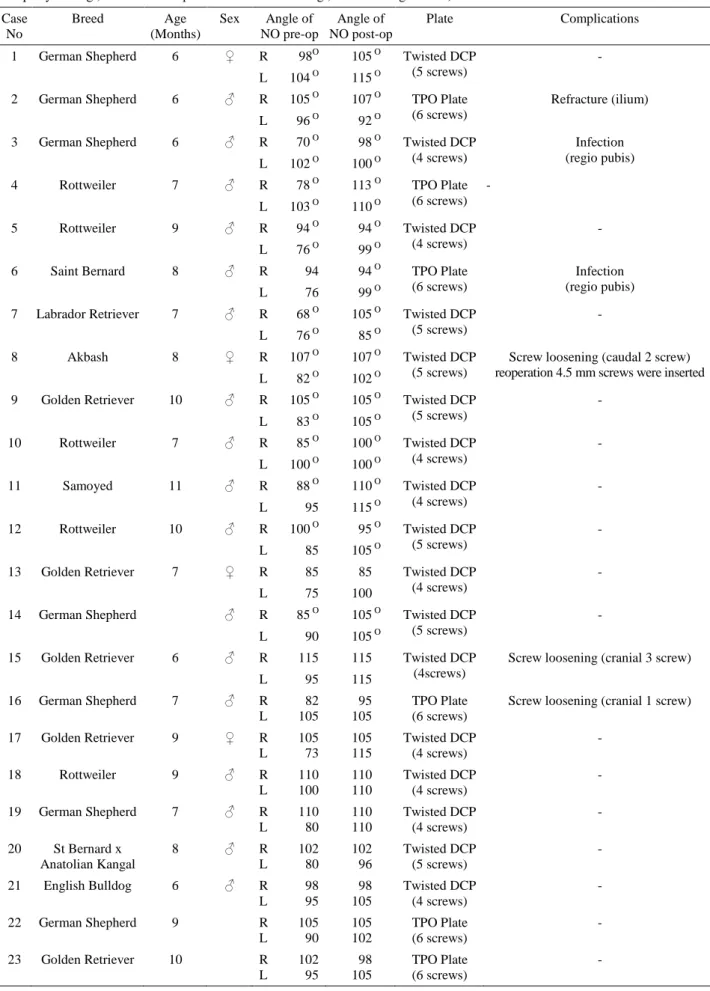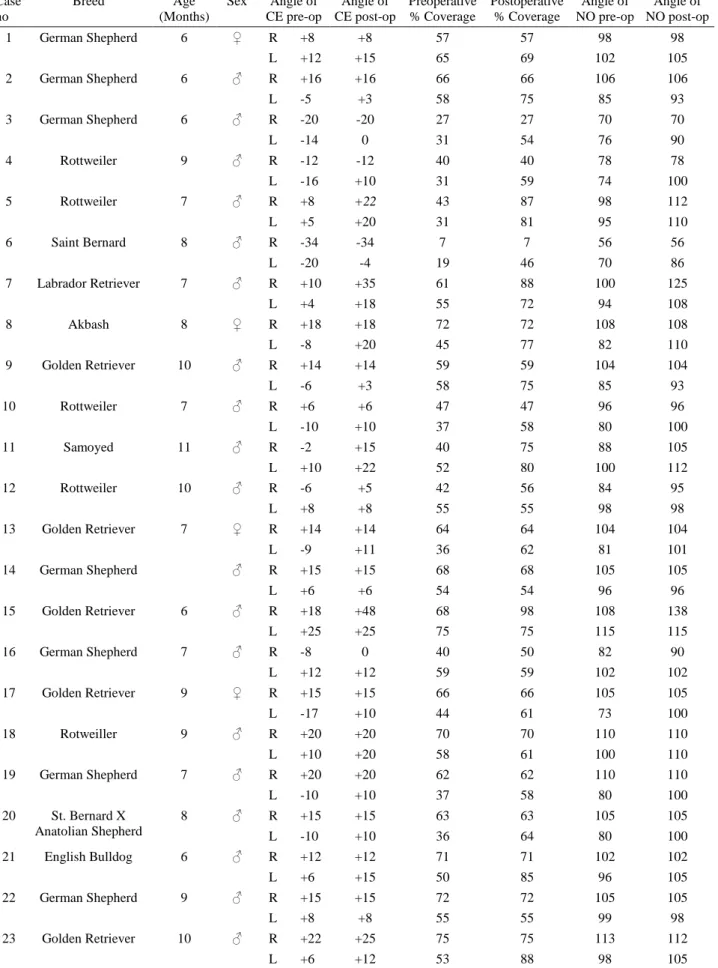Comparison of two different triple pelvic osteotomy plates for the
treatment of hip dysplasia in 23 dogs
Özge ÖZDEMİR
1, İrem GÜL SANCAK
2, Sinan ULUSAN
2, Barış KÜRÜM
3, Hasan BİLGİLİ
21Cumhuriyet University, Faculty of Veterinary Medicine, Department of Surgery, Sivas, 2Ankara University, Faculty of Veterinary
Medicine, Department of Surgery, Ankara, 3Kırıkkale University, Faculty of Veterinary Medicine, Department of Surgery, Kırıkkale, Turkey.
Summary: This study was performed on different breeds, age and sex 23 dogs, which were brought with canine hip dysplasia (CHD). All cases separated into randomized two groups. Although Standard Triple Pelvic Osteotomy (TPO) procedure and Standard TPO Plate were applied on the first group (6 cases), in the other (17 cases) Standard TPO procedure and Twisted Dynamic Compression Plate (DCP) plate were applied. Pre and postoperative Norberg-Olsson Angles (NO) was measured by Bs200Pro Software Programme (BsCelik, BAB Digital Imaging System 2007, Ankara, Turkiye) on computer imaging. Although group numbers are not equal we concluded that there were not any considerable difference shown between two groups. Twisted DCP group’s evaluation was found to be similar to evaluation of TPO Plate group. Twisted DCP is as effective as original TPO Plate for treatment of canine hip dysplasia.
Key words: Degenerative joint disease, dog, dysplasia, hip, triple pelvic osteotomy.
Yirmi üç köpekte kalça displazisinin sağaltımında iki farklı pelvik osteotomi plağı uygulamasının
karşılaştırılması
Özet: Bu çalışma, kalça displazili değişik ırk, yaş ve cinsiyette 23 köpek üzerinde gerçekleştirildi. Bütün olgular rastgele olarak 2 farklı gruba ayrıldı. Birinci gruba (6 olgu) standart Triple Pelvik Osteotomi (TPO) operasyonu ve standart TPO Plağı uygulanırken, 2. gruba (17 olgu) yine standart TPO operasyonu ve bükülmüş Dinamik Kompresyon Plağı (DCP) uygulandı. Tüm olguların preoperatif ve postoperatif Norberg-Olsson (NO) açıları Bs200Pro Software (BsCelik, BAB Digital Imaging System 2007, Ankara, Türkiye) programı ile ölçüldü. Sonuçta grup numaraları farklı olmasına ragmen gruplar arasında önemli bir farklılık izlenmedi. Bükülmüş DCP’dan elde edilen verilerin TPO Plağı’ndan alınan verilere yakın değerler olduğu belirlendi. Kalça displazisinin sağaltımında bükülmüş DCP’nın orjinal TPO Plağı kadar etkili olduğu sonucuna varıldı.
Anahtar sözcükler: Dejeneratif eklem hastalığı, displazi, kalça, köpek, üçlü pelvik osteotomi.
Introduction
Canine hip dysplasia (CHD) is a common developmental abnormality of young dogs (3-5), which is identified by the malformation of the caput femoris and acetabulum, increased laxity of surrounding soft tissues and degenerative joint disease (DJD) due to the articulatio coxae instability. It was first described by Schnelle in the 1937 (20).
Clinical diagnosis of CHD (5) can be made on the history of the animal, clinical signs and result of palpation by Ortolani (14), Bardens (1) and Barlow (2) tests. However, a definitive diagnosis is made only if characteristic signs of CHD are evident on radiographs of pelvis. CHD evaluation consists of a symmetric ventrodorsal radiograph of the pelvis and both femurs, with the hind limbs extended, femur parallel to each other and patella over the distal part of the femurs. The
x-ray beam is centered midway between the articulatio coxae (3, 11).
CHD has been diagnosed in almost all breeds of dogs (17), but it has the highest prevalence in giant breed dogs like Saint Bernard, and large breed athletic dogs like German shepherd, Rottweiler and Boxer (4, 5). Genetic and environmental factors influence the phenotypic expression of the disease. Some of the genetic and non-genetic factors that have been investigated were body size and weight (17), growth rate, nutrition (7, 18) and muscle mass (12, 18, 19, 27) but the main reason of the CHD still remains unknown.
Different surgical techniques have been described for treatment of CHD (6, 9, 10, 13, 15, 21, 22, 24-26). Some of them were designed to remove (excision arthroplasty) (25) or replace (total hip prosthesis) (13) the osteoarthritic joint. Other techniques such as intertrochanteric
osteotomy (26) and triple pelvic osteotomy (TPO) (8, 16, 21, 22) were designed to change the anatomical configuration of the articulatio coxae.
The aim of TPO is to improve joint stability by increasing caput femoris coverage. An increase in the load bearing area on TPO plate applied articulatio coxae, reduce the force imposed on the articular cartilage and limit the subsequent development of degenerative joint disease (8, 14, 15, 16, 21, 24). Since early 80’s (21,23) screws, wires and twisted dynamic compression plates (DCP) are widely used. The most common complications occur in these implants are implant breakage. Beginning from 1987 canine pelvic osteotomy plates are introduced in the market but these implants also bring some other complications like pelvic narrowing (24) due to their special design. Clinically and radiologically evaluated hip dysplasia positive dogs free from dysplastic malformations are included in the study.
The aim of the present study was to compare the clinical and radiological results between the canine TPO plate and twisted DCP for treatment of hip dysplasia in 23 dogs.
Material and Methods
In this study different breed, age and sex 23 dogs in total having hind limb lameness were studied. Clinical and radiological examination of hip joint was evaluated in detail. Breed distribution of the 23 affected dogs were as follows German shepherd (n=7), Rottweiler (n=5), Golden retriever (n=5), Labrador retriever (n=1), Samoyed (n=1), Akbash (n=1), Saint Bernard (n=1), English bulldog (n=1) and mixed Anatolian Shepherd (n=1). Ages were ranging between 6-11 months (mean 7.86 months). Of the cases 4 were female and 19 were male. Due to the preoperative clinical and radiological evaluations (Figure 1a, 3a), cases that were diagnosed CHD were included in our study. All cases were separated into two randomized groups.
Although standard Triple Pelvic Osteotomy (TPO) procedure and standard TPO Plate were applied on the first group (6 cases), in Twisted DCP group (Figure 2) (17 cases) standard TPO procedure and Twisted DCP were applied for treatment of CHD. Pre- and postoperative Norberg-Olsson Angles were measured (Figure 4). Initially the center of the each caput femoris is marked via horizontal line. These centers were connected with a line drawn between the two points. Cranial acetabular rim is identified and the edge of cranial acetabular rim is connected with a vertical line drawn between cranial acetabular rim and center of the caput femoris of each side. The angle between the two latter lines are measured. All measurements were calculated by Bs200Pro Software (Bs Celik, BAB Digital Imaging System 2007, Ankara, Turkey) on computer imaging (http://www.bab.com.tr/ ortopedi.html). Of the 23 cases 6 were treated with TPO Plate and 17 were treated with Twisted DCP.
Results
In TPOP group; Norberg-Olsson Angle (NO) measurement is limited in 78-96o, meanly 89o; although postoperative NO measurement is shown 92-113o, (mean 94.25o) and preoperative Center Edge of Acetabulum (CE) were associated with from (-34) to (+22), (mean 14.5), however postoperative CE were in from (-4) to (+25), (mean 12.58). Preoperative percentage of femoral coverage was limited in 7%-58%, (mean 47.91%) though postoperative ones are shown 7%-88%, (mean 57.66 %).
Figure 1: (a) Preoperative (V\D) radiographic view of pelvis, (b) Postoperative (V\D) radiographic view of pelvis after TPO Plate application.
Şekil 1: (a) Pelvisin preoperative (V\D) radyografik görünümü, (b) TPO Plağı uygulandıktan sonra pelvisin (V\D) radyografik görünümü.
In Twisted DCP group; preoperative NO angle measurement was limited to 73-113o (mean 94.94o) although postoperative NO measurement was shown 90-138o, (mean 104.26o). Preoperative Center Edge of Acetabulum (CE) were associated with from (-20) to (+25), (mean 16.05), however postoperative CE were in from (-34) to (+48), (mean 15.79). Preoperative percentage
Figure 2. Twisted TPO plate application in a cadaver. Şekil 2. Kadavrada bükülmüş TPO plağının uygulanması.
of femoral coverage was limited in 7%-75%, (mean 52.91%) though postoperative ones were shown 7%-98%, (mean 66.99%).
In TPO Plate group preoperative (V\D) (Fig 1a) and postoperative (V\D) radiographic views of pelvis (Fig 1b) in case 22. In Twisted DCP applied group preoperative (V\D) (Fig 3a) and postoperative (V\D) (Fig 3b) radiographic views of pelvis in case 21.
Complications observed were 6 cases in total and the distributions of the complications were as follows; infection (n= 2; one in Twisted DCP, one in TPO Plate), screw loosening (n=3; 2 in Twisted DCP, one in TPO Plate) (Figure 5) and ilium fracture (n=1; in TPO Plate group). In general, postoperative evaluations of CE angle showed that the angle was increased over 26.38%. Four cases are re-operated due to the complications. No correlation in between the screw loosening and plate type was found. Those that were loosened were changed with 4.5 mm diameter screws. Detailed information of the cases was listed in Table 1. Comparison of the angles was listed in Table 2.
Figure 3. (a) Preoperative (V\D) radiographic view of pelvis, (b) Postoperative (V\D) radiographic view of pelvis after Twisted DCP application.
Şekil 3. (a) Pelvisin preoperative (V\D) radyografik görünümü, (b) Bükülmüş DCP plağı uygulandıktan sonra pelvisin radyografik (V\D) görünümü.
Figure 4. Preoperative digital measurement of the hip angles. Şekil 4. Kalça eklemi açılarının preoperatif dijital ölçümleri
Figure 5. Postoperative complication (screw loosening) Şekil 5. postoperatif komplikasyon (vida gevşemesi)
Discussion and Conclusion
The aim of TPO is to re-stabilize the hip joint by increasing the rate of acetabular coverage of caput femoris and to prevent DJD formation due to increased hip joint laxity (8, 15, 16, 21, 24). The patients have to complete development of bone for hip joint adaptation against to anatomical and biomechanical modifications on hip joint. In this respect, TPO is more successful in younger patients (10-12 months-old-age) than the others (21, 24). The age was found to be a critical point on the case selection. TPO in dogs older 12 months of age is not recommended.
Juvenile pubic symphysiodesis (JPS) procedure is an alternative method to TPO. In JPS, the patients, have high risk of developing CHD, are determined via taking distraction radiography and intervened on pelvis before any clinical signs and degenerations on hip joint is not occurred.
Youngsters are not brought to veterinary clinics for routine hip joint check with distraction radiography method, so in juvenile dogs there is a high risk of CHD development. Usually they are brought to clinics when progression of the dysplasia starts and the lameness due to DJD formation is the predominant sign (22). In our study, major complaint was hind limb lameness. Mean age was 7.86 months (7-11month).
Broadly accepted, before DJD progression started TPO should be applied (21, 23, 24). However, a well-known and acceptable OA degree has not been established. There is no certain critical point (numerical value) that warns us about the TPO procedure. In conclusion, osteoarthritic changes starts early before the hip joint operation decision. When the OA is severe, femoral head and neck osteotomy or total hip arthroplasty should be applied (22).
A number of different type TPO plates are produced for TPO procedure and used worldwide (6, 11, 21-24, 27). This type of TPO plate has different acetabular ventroversion (AVV) angles and different number of screw holes although some literatures (6, 22) mentioned that Standard DCP plate, twisted in an appropriate angle, is used as TPO plate. There are different opinions about rotation degree of acetabulum for AVV degree. In present study, 30˚ AVV angle is found to be a sufficient (24). Both the DCP and TPO Plate is twisted 20˚. Due to the periarticular forces on hip joint DCP is twisted in 20˚ for rotation with 0-20˚ of AVV (6). However considerable decreasing of periarticular forces maintained. This is achieved by increasing the contact surface of the joints. In postoperative evaluations, CE angles were increased above 26.38%. So, increase in the contact surface of joint is maintained by acetabular rotation.
In TPOP group; Norberg-Olsson Angle (NO) measurement was 78-96o, (mean 89o) and postoperative NO measurement was increased to 92-113o, (mean 94.25o)
Table 1: Clinical and radiological pre and post-op data (♀: Female, ♂: Male, R: Right, L: Left, Twisted DCP: Twisted Dynamic Compression Plate, TPO Plate: Triple Pelvic Osteotomy Plate, NO: Norberg-Olsson).
Tablo 1: Pre ve postoperatif klinik radyografik veriler (♀: Dişi, ♂: Erkek, R: Sağ, L: Sol, Twisted DCP: Twisted Dinamik Kompresyon Plağı, TPO Plate: Triple Pelvik Osteotomi Plağı, NO: Norberg-Olsson)
Case No Breed Age (Months) Sex Angle of NO pre-op Angle of NO post-op Plate Complications
1 German Shepherd 6 ♀ R 98O 105 O Twisted DCP (5 screws)
- L 104 O 115 O
2 German Shepherd 6 ♂ R 105 O 107 O TPO Plate
(6 screws)
Refracture (ilium) L 96 O 92 O
3 German Shepherd 6 ♂ R 70 O 98 O Twisted DCP
(4 screws)
Infection (regio pubis) L 102 O 100 O
4 Rottweiler 7 ♂ R 78 O 113 O TPO Plate
(6 screws) - L 103 O 110 O 5 Rottweiler 9 ♂ R 94 O 94 O Twisted DCP (4 screws) - L 76 O 99 O
6 Saint Bernard 8 ♂ R 94 94 O TPO Plate
(6 screws)
Infection (regio pubis)
L 76 99 O
7 Labrador Retriever 7 ♂ R 68 O 105 O Twisted DCP (5 screws)
- L 76 O 85 O
8 Akbash 8 ♀ R 107 O 107 O Twisted DCP
(5 screws)
Screw loosening (caudal 2 screw) reoperation 4.5 mm screws were inserted L 82 O 102 O
9 Golden Retriever 10 ♂ R 105 O 105 O Twisted DCP (5 screws) - L 83 O 105 O 10 Rottweiler 7 ♂ R 85 O 100 O Twisted DCP (4 screws) - L 100 O 100 O 11 Samoyed 11 ♂ R 88 O 110 O Twisted DCP (4 screws) - L 95 115 O 12 Rottweiler 10 ♂ R 100 O 95 O Twisted DCP (5 screws) - L 85 105 O
13 Golden Retriever 7 ♀ R 85 85 Twisted DCP
(4 screws)
-
L 75 100
14 German Shepherd ♂ R 85 O 105 O Twisted DCP (5 screws)
- L 90 105 O
15 Golden Retriever 6 ♂ R 115 115 Twisted DCP (4screws)
Screw loosening (cranial 3 screw)
L 95 115 16 German Shepherd 7 ♂ R 82 L 105 95 105 TPO Plate (6 screws)
Screw loosening (cranial 1 screw)
17 Golden Retriever 9 ♀ R 105 L 73 105 115 Twisted DCP (4 screws) - 18 Rottweiler 9 ♂ R 110 L 100 110 110 Twisted DCP (4 screws) - 19 German Shepherd 7 ♂ R 110 L 80 110 110 Twisted DCP (4 screws) - 20 St Bernard x Anatolian Kangal 8 ♂ R 102 L 80 102 96 Twisted DCP (5 screws) - 21 English Bulldog 6 ♂ R 98 L 95 98 105 Twisted DCP (4 screws) - 22 German Shepherd 9 R 105 L 90 105 102 TPO Plate (6 screws) - 23 Golden Retriever 10 R 102 L 95 98 105 TPO Plate (6 screws) -
Table 2: Signalment, clinical and radiological data of 23 dogs with hip dysplasia (♀: Female, ♂: Male, R: Right, L: Left, NO: Norberg-Olsson, CE: Center Edge of Acetabulum).
Tablo 2: Kalça displazili 23 olguya ait signalement, klinik ve radyolojik veriler (♀: Dişi, ♂: Erkek, R: Sağ, L: Sol, NO: Norberg-Olsson, CE: Asetabulum merkez açısı)
Case no Breed Age (Months) Sex Angle of CE pre-op Angle of CE post-op Preoperative % Coverage Postoperative % Coverage Angle of NO pre-op Angle of NO post-op 1 German Shepherd 6 ♀ R +8 +8 57 57 98 98 L +12 +15 65 69 102 105 2 German Shepherd 6 ♂ R +16 +16 66 66 106 106 L -5 +3 58 75 85 93 3 German Shepherd 6 ♂ R -20 -20 27 27 70 70 L -14 0 31 54 76 90 4 Rottweiler 9 ♂ R -12 -12 40 40 78 78 L -16 +10 31 59 74 100 5 Rottweiler 7 ♂ R +8 +22 43 87 98 112 L +5 +20 31 81 95 110 6 Saint Bernard 8 ♂ R -34 -34 7 7 56 56 L -20 -4 19 46 70 86 7 Labrador Retriever 7 ♂ R +10 +35 61 88 100 125 L +4 +18 55 72 94 108 8 Akbash 8 ♀ R +18 +18 72 72 108 108 L -8 +20 45 77 82 110 9 Golden Retriever 10 ♂ R +14 +14 59 59 104 104 L -6 +3 58 75 85 93 10 Rottweiler 7 ♂ R +6 +6 47 47 96 96 L -10 +10 37 58 80 100 11 Samoyed 11 ♂ R -2 +15 40 75 88 105 L +10 +22 52 80 100 112 12 Rottweiler 10 ♂ R -6 +5 42 56 84 95 L +8 +8 55 55 98 98 13 Golden Retriever 7 ♀ R +14 +14 64 64 104 104 L -9 +11 36 62 81 101 14 German Shepherd ♂ R +15 +15 68 68 105 105 L +6 +6 54 54 96 96 15 Golden Retriever 6 ♂ R +18 +48 68 98 108 138 L +25 +25 75 75 115 115 16 German Shepherd 7 ♂ R -8 0 40 50 82 90 L +12 +12 59 59 102 102 17 Golden Retriever 9 ♀ R +15 +15 66 66 105 105 L -17 +10 44 61 73 100 18 Rotweiller 9 ♂ R +20 +20 70 70 110 110 L +10 +20 58 61 100 110 19 German Shepherd 7 ♂ R +20 +20 62 62 110 110 L -10 +10 37 58 80 100 20 St. Bernard X Anatolian Shepherd 8 ♂ R +15 +15 63 63 105 105 L -10 +10 36 64 80 100 21 English Bulldog 6 ♂ R +12 +12 71 71 102 102 L +6 +15 50 85 96 105 22 German Shepherd 9 ♂ R +15 +15 72 72 105 105 L +8 +8 55 55 99 98 23 Golden Retriever 10 ♂ R +22 +25 75 75 113 112 L +6 +12 53 88 98 105
and preoperative Center Edge of Acetabulum (CE) was increased from (-34) to (+22), (mean 14.5), to (-4) to (+25), (mean 12.58). Preoperative percentage of femoral coverage was limited in 7%-58%, (mean 47.91%) though postoperative ones are shown 7%-88%, (mean 57.66 %). In Twisted DCP group; preoperative NO angle measurement was 73-113o (mean 94.94o) and postoperative NO measurement was increased to 90-138o, (mean 104.26o). Preoperative Center Edge of Acetabulum (CE) was (-20) to (+25), (mean 16.05), and and postoperative CE was increased to (-34) to (+48), (mean 15.79). Preoperative percentage of femoral coverage was 7%-75%, (mean 52.91%) and postoperative ones were shown 7%-98%, (mean 66.99%).
The most common complication of TPO procedure is implant failure (6, 11, 21-24). In this study, TPO is applied to 23 cases and screw loosening (n=3), refracture (n=1) and infection (n=2) were observed. 4 cases were re-operated due to complications. Of the 23 cases 6 were operated with TPO Plate. Screw loosening (n=1) and ilium refracture (n=1) was observed. Of the 23 cases 17 were operated with Twisted DCP. Screw loosening (n=2) and infection (n=1) was observed. 4 cases were re-operated due to complications. But there was no correlation found between on screw loosening and plate type. Loosen screws were changed with 4.5 mm diameter screws.
Koch et al. (11) reported that there was no significant variation and considerable decreasing of dorsal pelvic diameter in unilateral application, used Twisted DCP and TPO Plate. In Twisted DCP is used in young cases so the decrease in pelvic diameter is well tolerated by persistent pelvic growing.
In conclusion, any considerable difference could not be shown in between two groups. So, Twisted Dynamic Compression Plate (twisted in 20 degree) results were similar to the TPO Plate group. Twisted DCP is found to be as effective as original TPO plate.
References
1. Bardens JW (1972): Palpation for the detection of joint
laxity, in Proceedings AVMA Symp. Hip Dysplasia, 105-109. 2. Barlow JG (1962): Early diagnosis and treatment of congenital dislocation of the hip. J Bone Joint Surg Br, 44, 292-301.
3. Çaptuğ Ö, Bilgili H (2006): Can early diagnosis of canine hip dysplasia be possible? J Turkish Vet Med Assoc, 77, 22-25.
4. Çaptuğ Ö, Bilgili H (2006): Current Approaches of Canine Hip Dysplasia. Part I.: Etiology and Pathogenesis of Canine Hip Dysplasia. J Fac Vet Med Univ Erciyes, 3, 123-128.
5. Çaptuğ Ö, Bilgili H (2007): Current Approaches of Canine Hip Dysplasia. Part II.: Clinical Diagnosis of Canine Hip Dysplasia. J Fac Vet Med Univ Erciyes, 4, 35-42.
6. Dejardin LM, Perry RL, Arnoczky SP (1996): The effect of triple pelvic osteotomy on hip forces in dysplastic dogs, a theoretical analysis. Vet Surg, 25, 114-120.
7. Hazewinkel HAW (1998): Nutritional influences on hip dysplasia. 9th Annual ESVOT Congress. 16th-19th 1998
Munich, Germany. Congress Book, 7-9.
8. Hazewinkel HAW, Meij BP (1998): Triple pelvic osteotomy (TPO) for the treatment of hip dysplasia. Vet Quart, 20, 25-26.
9. Hohn RB, Janes JB (1969): Pelvic osteotomy in the treatment of canine hip dysplasia. Clin Orthop, 62, 70-78. 10. Hunt GA, Litsky AS (1988): Stabilization of canine
pelvic osteotomies with AO/ASIF plates and screws. VCOT, 1, 52-57.
11. Koch DA, Hazewinkel HAW, Nap RC, et al (1993): Radiographic evaluation and comparison of plate fixation after triple pelvic osteotomy in 32 dogs with hip dysplasia. VCOT, 6, 9-15.
12. McLauglin R Tomlinson J (1996): Symposium on CHD: Diagnosis and medical treatment. Vet Med, 91, 25-53. 13. Olmstead ML (1987): Total hip replacement. Vet Clin
North Am Small Anim Pract, 17, 943-955.
14. Ortolani M (1976): Congenital hip dysplasia in the light of early and very early diagnosis. Clin Orthop, 119, 6-10. 15. Pauwels F (1976): Biomechanics of the normal and
diseased hip. Springer-Verlag, Berlin, 1-37.
16. Poss R (1984): The role of osteotomy in the treatment of osteoarthritis of the hip. J Bone Joint Surg (Am), 66, 144-151. 17. Priester WA, Mulvihill JJ (1972): Canine hip dysplasia: Relative risk by sex, size, and breed, and, comparative aspects. J Am Vet Med Assoc, 160, 735-739.
18. Richardson D (1992): The role of nutrition in canine hip dysplasia. Vet Clin North Am Small Anim Pract, 22, 529-540. 19. Riser WH, Rhodes WH, Newton CD (1985): Hip dysplasia. 953-997. In: Newton CD, Nunamaker DM (Eds), Textbook of Small Animal Orthopedics. JB Lippincott Co, Philadelphia.
20. Schnelle GB (1937): Congenital subluxation of the coxofemoral joint in a dog. Univ Pa Bull., 65, 15-16. 21. Schrader SC (1981): Triple osteotomy of the pelvis as a
treatment for canine hip dysplasia. J Am Vet Med Assoc,
178, 39-44.
22. Schulz KS, Dejardin LM (2003): Surgical treatment of canine hip dysplasia. 2029-2059. In: Slatter DH (Eds), Textbook of Small Animal Surgery. Saunders Co, Philadelphia,
23. Slocum B, Slocum TD (1986): Pelvic osteotomy technique for axial rotation of the acetabular segment in the dogs. J Am Anim Hosp Assoc, 22, 331-338.
24. Slocum B, Slocum TD (1987): Pelvic osteotomy in the dog as a treatment for hip dysplasia. Semin Vet Med Surg,
22, 107-116.
25. Speull JS (1961): Excision arthroplasty as a method of treatment of hip joint disease in the dog. Vet Rec, 73, 573-576. 26. Walker TL, Prieur WD (1981): Intertrochanteric femoral
osteotomy. Semin Vet Med Surg, 2, 117-130.
27. Wallace L (1987): Canine hip dysplasia: Past and present. Semin Vet Med Surg (Small Anim), 2, 92-106. Geliş tarihi: 01.04.2014/ Kabul tarihi: 08.10.2014
Address for correspondence:
Dr. İrem Gül Sancak University of Ankara,
Faculty of Veterinary Medicine, Department of Surgery, Ankara. e-mail: iremgulsancak@gmail.com
